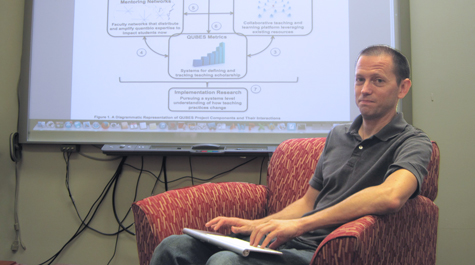Mathematical biologist will help to build NSF-funded QUBES hub
Drew LaMar is a mathematician imbedded in William & Mary’s biology department, a response to a growing imperative that undergraduate biology students acquire a better grounding in quantitative and computational methods.
Now, LaMar is working to spread the biomath revolution as part of QUBES, a National Science Foundation-funded initiative. LaMar is the principal investigator on a $935,551 NSF grant to form a virtual “hub,” where mathematicians and biologists can share information and ideas of best practices. It’s one of three collaborative proposals that received a total of $2.9 million from the NSF.
LaMar says one driver of the need for young biologists to become comfortable with quantitative and computational approaches is simple to explain.
“It’s data. Massive amounts of data,” he said. “With today’s technology, it’s getting easier and easier to measure stuff. We have so much data we don’t always know what to do with it—unless you start data analysis.”
Biologists in the data-drenched 21st century have found that they need to understand data analysis and therefore computer skills and statistics are becoming more important, he said. A new Latinate phrase has joined the traditional pair of in vitro (an observation made in the lab) and in vivo (an observation made in an organism). The new phrase, in silico, outlines the growing importance of mathematical modeling in scientific and clinical work.
“You can actually set up and run an experiment on a computer,” he explained. “If you look at the biological world, it’s highly variable and there are lots of components interacting in very non-trivial ways. We’re trying to understand and maybe even to control these systems, but it’s very hard to do that without using some kind of mathematical tools.”
The second driver, LaMar explained, is too little data, or rather the emergence of computational tools to address situations in which hard information is sparse. In such cases, mathematical modeling can help to fill in the data blanks.
He cited the current Ebola outbreak in Africa as an instance in which mathematical modeling is being valuable as a epidemiological tool for health care professionals and government officials dealing with the spread of the deadly virus.
“Obviously you can’t give Ebola to people and have a control group,” La Mar said. “Mathematical modeling is a great example in that situation because it can be really helpful. You can try to control for confounding factors that you wouldn’t be able to do in an observational experiment. Then you can ask the same kind of questions that you could if you did a designed experiment.”
LaMar’s position as the biology department’s resident mathematician was initially funded by the Howard Hughes Medical Institute (HHMI), which has supported William & Mary’s Biomathematics Initiative for years. QUBES—Quantitative Undergraduate Biology Education and Synthesis—is a multilayered collaboration to enrich undergraduate biology curricula nationwide, using quantitative approaches and methods such as those being used at William & Mary.
LaMar explained that William & Mary is a top-level collaborator, along with the University of Pittsburgh and the University of Wisconsin-Madison.
In the case of William & Mary, LaMar, the principal investigator on William & Mary’s NSF grant, will work with co-PIs at Radford University, Roanoke College and Unity College. Their charge is to develop QUBES’ digital “hub,” a centralized repository of new and preexisting quantitative-biology resources, but LaMar said he wants the hub to be more than a static Cloud-based library of files and links.
“The idea is to create a sort of sandbox, a place where educators in mathematical biology can go and find resources, know how those resources are being used and know the success of those resources in the classroom,” he said. “We also want this hub to be a place where people can build and modify these resources in a collaborative way.”
In addition to the hub, there are three other main components to the initiative:
• QUBES Consortium: A collaboration to bring together societies and institutions to leverage the power of all groups working on quantitative biology education.
• QUBES Mentoring Networks: An international network of mentors for young faculty starting in quantitative biology.
• QUBES Metrics: Develop and encourage the adoption of systems to define and track teaching and scholarship in quantitative biology.
















